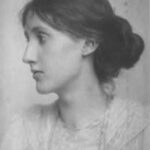Jackson Pollock was a famous abstract expressionist painter in the 1940’s and 1950’s. The idea that Pollock primarily worked from was the idea about painting the unconscious. However, one has to question, was he really painting out of the unconscious, or was he rather incorporating and using vivid ideas from his life mixed with feelings created unrealistically from his life-long problems with alcohol?
The true story behind Jackson Pollock, besides him working with Peggy Guggenheim and being one of the most well-known painters of his time, was that his life was plagued by alcoholic rages, self hatred and manic depression, all of which ultimately caused his death. With his wife , Lee Krasner, a Russian Jewish artist, with whom he had a disaster-driven relationship, moved away with Jackson in 1946 so that Jackson could experience a more “freeing” effect with his work.
Being a positive support of his art, she encouraged him to release himself within the art and to not hit the drink so hard, which is why Pollock went through a period in his life where he didn’t consume alcohol for almost four years. Also during this time, in the 1940’s, he began to allow his work to take on a life of it’s own, beginning to design mural sized, drip paintings which he became famous for. He did not execute his murals with normal painting utensils and styles such as tedious brush work, but rather, he dripped and threw the paint using hand and wrist gestures. He also inclined to use more indistrial tools such as trowels, knives, and sticks to apply paint to canvas. Also, one of the things that was rather interesting about Pollock was that he did not use normal oil or acrylic paint; he used house paint, liquid paint, and plaster. Even though he did give up alcohol for about four years, he always drew back to it for some reason, and although the drink seemed to inspire his creativity in art, he was a stark alcoholic.
During the 1940’s, Pollock’s glory years, his work developed into abstract expressions of unconscious imagery which was influenced by his radical psyche. As stated by Michael Leja, “Pollock was having difficulty communicating with Dr. Joseph Henderson and so offered to bring to their sessions some of his work for discussion. This suggestion is the earliest identification that Pollock had begun to believe that his work contained psychologically revealing material.”1 According to this statement, it seems to reveal that Pollock’s psychologist was aiding him in the process of condoning his work as being, in fact, psychological and enlightening of the unconscious. These drawings, being created from an assortment of stimuluses, helped Pollock find his way. However, Pollock, still motivated by alcoholism and depression, ended up hospitalized himself, and there he found support under the wings of Dr. Henderson from 1939-1940. Another quote directly from Leja affirms that, “Pollock asserted that the source of his painting was the unconscious — as if he apparently believed, the sources of all of these paintings, with their various approaches to imagery and paint handling, were in the unconscious.”2 And also, from the book Art in Theory 1900-2000 , Pollock makes the testimonial, “When I am painting, I’m not aware what I am doing — The source of my painting is the unconscious.”3 Then yet, another reference avowed by Leja provokes a strong, firm questioning behind Pollock’s aspirations, “The unconscious is not a fixed, transhistorical, pre-existent entity whose structure and contents can be discovered by scientific investigation. It is rather as Peter Berger emphasized, a conceptual construction socially determined originating in social processes of identity production and confirmation.”4
The unconscious is being explained here as a matter of concept. The unconscious is a perception rather than an actuality, and that the unconscious is also a model that is structuralized by society and is administered or created by the production of self-identity and confirmation within society. It is known of Pollock that he was in a mental state where he did not comprehend who he was, or where he stood in the populace, and this lead to his untimely death by car crash on August 11, 1956. As illustrated by Dennis Raverty, “Pollock also took on the aura of a pop-existential hero: a lonely, sensitive, misunderstood genius.”5 And moreover stated by Elisabeth Langhorne, “In Healing of the Blind , Pollock draws a rare self-image — with such passages taken from other paintings in such a way as to suggest a personal search.”6 Pollock felt alone, he was sensitive, and completely misunderstood by society, or that was undeniably his contemplation. Perhaps, because of this, that was why he genuinely felt separated and indistinct from the society that helps one to appreciate being a human being. So was Pollock justly one who was walking the lonely road of solitude and searching for approval or some key signature from society to confirm his self-identity and conceptuality? Leja had this reflection about Pollock’s vocation, “Is the meaning of these paintings to be discovered in what they tell us of Pollock’s psychic condition, encoded in Jungian symbolism, or are the psychological elements really only the props for an essentially deliberate process of ambitious artmaking?”7 Jungianism appealed to Pollock because the purpose of it served him in a way such that Jungianism, being the teaching of apprehension and integration of the deep forces and motivations underlying human behavior, caused Pollock to acquire an interest in the practices of phenomenology, dreams, mythology, and folklore, and as well a “fascination with certain Christian themes”, as stated by Langhorn. 8 As Leja explains, “Pollock’s direct and explicit engagement with particular Jungian concepts prepares us to recognize less exact and circumscribed evidence of Jungian debts in the drawings. These reveal the Jungian theory colored by Pollock’s early efforts to come to terms with the idea of unconscious in some profound and lasting ways.” 9
Besides Leja p resenting the unconscious as an “idea”, he also asserts firmly that Pollock was directly stimulated by Jungianism, which he learned of at his psychiatric visits when he hospitalized himself, and this effected the impressions of his work and his ideas and the direct quotations of his work which characterized his unconsciousness specifically. As with his fascinations with mythology, folklore, and dreams, besides being influenced by Carl Jung and Sigmund Freud, it speaks to say that it is representative of his past. Pollock was born in Cody, Wyoming and moved also to Arizona and California in his younger years. He was commonly among groups of Native Americans such as the Sioux-Cheyanne, Apache, and the Chumash, and he became quite accustomed to living on reservations. Native American heritage commonly expresses within their culture, the influence of magic, folklore, and mysticism. Native heritages believed in gods that ruled the soils, skies, and waters. And in addition, Natives had a belief that everything possessed a spirit. Another detail that is known of Pollock is in his late teens he attended an art school in Los Angeles where he was exposed to Mexican muralists. As stated by Soussloff, “Pollock learned some things about mural painting and radical politics from Siquieros but he had exposure to both before he went to work with Siquieros in 1936.” 10 This was another cultural influence, but additionally the fact that most of the drip paintings that Pollock produced, and which he was most famous for, were all mural sized portraits ranging from 9 x 18 ft. But all, in turn, as described by Soussloff, “Pollock’s painting procedures have been seen by numerous others as substitutes, or even temporary cures, for the effects that he sought from his overuse of alcohol. More psychoanalytically, Pollock’s physical expression in the abstract paintings must be related differently to his addiction-to the deeper emotional wound that it obviously seeks to heal.” 11 Pollock lost his father as a child. The gap that was left in Pollock’s life after he died, could not be filled, and many times over Pollock drew to his love for his father and developed a fight or flight nature, desiring to partially return to his father in a homage-type mindset, but most of all, what he was seeking was described by Soussloff, “relief from the pain of departure during childhood.” 12
Another unfortunate cause, besides the fatality of his father, was another very damaging incident that cost Pollock moderately his sanity. As stated by Langhorne, “After his platonic girlfriend, Rebecca Tarwater, had refused his proposal of marriage and his drinking had led to his dismissal from the Federal Art Project, he himself chose to enter the Westchester psychiatric division of New York Hospital for treatment of acute alcoholism.” 13 Within the hospital, Jackson began to draw more upon the influences of women within art. His ex-girlfriend being a significant inspiration on the aspirations within his drawings at the time was depicted by Langhorne, “Pollock’s preoccupation with women is actively displayed.” 14 Also, one thing that stood out in Pollock’s drawings while he was in intensive care he had a deep anger towards women. Within his drawings he drew womanly figures with scenes of damnation and fire, skewed faces, gangly hair, and sometimes the woman or women were displaying herself/themselves as Langhorne describes of Pollock during 1943, “the artist has now transposed the female’s availability into an all-over painterly, automatist energy, poised to possess the female.” 15 It is apparent that during his stay at the hospital that Pollock was enraged at his girl-friend’s refusal so much that during his studies of classical arts, for example when he analyzed Michelangelesque figures, and he created the male figure that was crushed, then hereafter designing the woman within damnation. Pollock felt trampled and it is seen that this young woman was part of the cause of his torment within his psyche. However, in 1943, three years after his hospitalization, as Langhorne had articulated, he was using the female imagery that he was so frustrated with towards creating art that was based off of his inability to be wed and more towards a woman’s ability to be available. He turned the negativity into a workable, usable means of creating art, in which he used women’s imagery to create various silk-screens in 1943 before he transferred into producing his famous, 9 x 18 ft mural paintings.
As seen in the portrait by Jackson Pollock called The Moon Woman , a feminine figure is definitive, although not accurately proportioned. This is because Pollock was portraying a fascination in two artists that he studied while he was hospitalized: Pablo Picasso and Joan Mir³. Pablo Picasso being a famous sculptor, painter, and designer, co- established the Cubist Movement. Joan Mir³, on the other hand, was an artist of the Surreal, focusing his talent around the subconscious mind, and Mir³, in addition, was in opposition against the traditional ways of painting as supported by the bourgeoisie. Pollock’s, The Moon Woman, of 1942 expresses both appeals of these two artists. The color palettes of The Moon Woman communicate the influences of Pablo Picasso because the intensity of the paints used matches the wildly vibrant works shaped by Picasso during WWII. Also the influence of Picasso’s Cubism was a direct effect. The woman within the piece is abstract, her head more the shape of an almond, her body several loosely painted lines, her arm reminiscent of rope than an actual arm, and her back bone is one continual black line in which the curvation of her body is denoted. Also, with the inspiration of Joan Mir³, the painting has both anterior and contour views, the face representing two dissimilar characteristics of the self-conscious: one that is tranquil and municipal, and the other shadowy and mediocre.
The Moon Woman , was created during the time period after Jackson Pollock was hospitalized and had been under the influence of Dr. Henderson. It is known that during his hospitalization, as stated earlier, that he reflected an infatuation with femininity. However, then after his hospital visit he focused and turned his negativity of the female into inspiration for him as a means to create works of art. The influence of this is shown in The Moon Woman because Pollock represents this certain female as having two distinct views as if the woman herself had two different dispositions. This portrait could therefore be the direct influence of his ex-girlfriend, expressing her two different auras or humors.
Another aspect to consider about this piece is that after the visits with Dr. Henderson, Jackson Pollock began to think that his pieces revealed psychologically disclosing material about his unconscious. Although providing that the unconscious is in fact a perception rather than an actuality, and that the unconscious is a model that is structuralized by society and helps in aid one in acquiring self-knowledge, as again avowed from earlier, much is to say about Pollock’s state of mind during the creation of this piece. The two different sides of the piece could therefore represent not just the woman who had rejected him, but also his own state of mind. Jackson was constantly on the search for some deep perception about whom he was, and also as Jackson stated himself in an interview with William Wright in the book Art in Theory 1900-2000 , “The modern artist is working with space and time, and is expressing his feeling rather than illustrating.” Pollock incorporated his own sentiments and articulations within the The Moon Woman, the figure in the portrait has two dispositions, but so does Pollock. This is to say that Pollock had a side to him that was public and placid, the side that most people seen of him, but then there was another side as well that was dark and obsolete.
Another attractive quality about this painting was that Pollock began to use trowels, sticks, and bushes unconventionally. This artwork is uneven, the bright, vivid red was shoveled on by a trowel rather than a paint brush, and the cherry color was smeared across the canvas in a disproportionate manner rather than being delicately spread. The color is fervently applied in such a way to suggest that Pollock enthusiastically spaded paint over the top of more paint. For example, on the intense scarlet there are smoky hazes of black, yellow, and oranges. And within the cyan there are many different blemishes of color to imply that Pollock was rather throwing a saturated paintbrush or stick at the canvas to create odd, irregular dots.
The way that he uses the trowels, paint brushes, and branches to apply paint to the canvas within this piece lead Pollock to the making his first few enormous, mural-sized splatter masterpieces that he began to generate in the mid-forties. The Moon Woman was just one of the few pieces that Pollock fashioned during the early forties as experimentations for future work with Peggy Guggenheim in 1945. From these techniques that Pollock made, he was the first modern painter described as an “action painter”, and also, because he was more inspired by the aspirations of his life and his addictions rather than honestly expressing the unconscious, he was one of the most well-known modern painters of the WWII era to the mid-fifties.
Endnotes
1. Michael Leja, “Art History,” Jackson Pollock: Representing The Unconscious 13 (1990): 545.
2. Ibid., 544.
3. Harrison, Charles, and Paul Wood, eds., Art in Theory 1900-2000 (Malden: Blackwell Publishing, 1993) 571.
4. Michael Leja, “Art History,” Jackson Pollock: Representing The Unconscious 13 (1990): 544.
5. Dennis Raverty, “Midwest Quarterly,” The Needs of Postwar America and the Origins of the Jackson Pollock Myth 43(2002): 337.
6. Elisabeth Langhorne, “Art Journal,” Evolution and Revolution 58(1999): 113.
7. Michael Leja, “Art History,” Jackson Pollock: Representing The Unconscious 13 (1990): 546.
8. Elisabeth Langhorne, “Art Journal,” Evolution and Revolution 58(1999): 113.
9. Michael Leja, “Art History,” Jackson Pollock: Representing The Unconscious 13 (1990): 548.
10. Catherine Soussloff, “The Drama Review,” Jackson Pollock’s Post-Ritual Performance: Memories Arrested in Space 48(2004): 69.
11. Ibid., 70-71.
12. Ibid., 71.
13. Elisabeth Langhorne, “Art Journal,” Evolution and Revolution 58(1999): 113-114.
14. Ibid., 114.
15. Ibid., 114.
16. Harrison, Charles, and Paul Wood, eds., Art in Theory 1900-2000 (Malden: Blackwell Publishing, 1993) 584.
Works Cited
Foster, Hal, Krauss, Bois, and Benjamin Buchloh. Art Since 1900, Modernism Antimodernism, Postmodernism, 1945 to the Present. New York, NY: Thames & Hudson Inc., 2007
Harrison, Charles, and Paul Wood. Art in Theory 1900-2000. Malden, MA: Blackwell Publishing, 1993.
Langhorn, Elizabeth. “Evolution and Revolution.” Art Journal 58(1999): 112-115. Print.
Leja, Michael. Jackson Pollock: Representing The Unconscious.” Art History 13(1990): 540-565. Print.
Raverty, Dennis. “The Needs of Postwar America and the Origins of the Jackson Pollock Myth.” Midwest Quarterly 43(2002): 337-345. Print.
Soussloff, Catherine. “Jackson Pollock’s Post-Ritual Performance: Memories Arrested in Space.” The Drama Review 48(2004): 60-78. Print.
Sweet, David. “Parodic Nostalgia for Aesthetic Machismo: Frank O’Hara and Jackson Pollock.” Journal of Modern Literature 23(2000): 375-391. Print.





